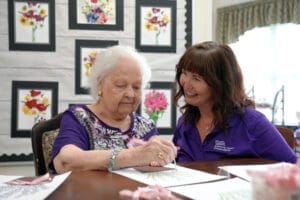Today’s assisted living communities offer the perfect option for aging adults to maintain the best overall quality of life possible, especially those who may need some help with daily activities. Residents enjoy the comfort of a home-like environment with caring and dedicated staff that will help them live life on their own terms.
So, who is the typical assisted living resident? What made them choose to live in a senior living community setting? How long will they live there? Let’s take a deeper dive into the demographics of today’s assisted living communities.
Gender and Assisted Living Communities
The typical assisted living resident is described as a mobile female around the age of 87 years old. While she is still mostly independent, she does require some help with at least two or three daily living activities, like bathing, dressing, eating, or medication management. She also might have some chronic conditions like osteoporosis or high blood pressure.
The reason there are more women than men in assisted living is simply because women tend to outlive men. According to the World Health Organization, in general women live longer than men, on average by six to eight years. However, the average lifespan for men in the United States is starting to increase; according to the Social Security Administration, a man reaching age 65 today can expect to live until age 84.3, on average, while a 65 year old woman can expect to live until age 86.6. Therefore, it stands to reason that more and more men will also be entering assisted living communities in the coming years.
More Facts about Assisted Living
According to the American Health Care Association (AHCA) and National Center for Assisted Living (NCAL), in 2020 there were approximately 28,900 assisted living communities with nearly 1 million licensed beds in the United States today. The average size of an assisted living community is 33 licensed beds. There are approximately 811,500 residents nationwide (71% women, 29% men), and more than half the residents are 85 years and older.
While 76% of residents living in an assisted living community moved there from their own home or apartment, or possibly a family residence, some seniors are moved to a community setting after a hospital stay or from a rehabilitation facility. Some of these seniors made the move due to the fact that they have no adult children to assist them, or their children live too far away or are unavailable to provide care. Or, they have serious health conditions that require professional assistance. The majority of these residents, 35% of them, will remain in assisted living for a year or longer, while 16% will stay for three years or more.
Assisted living communities help promote independence among residents while offering the chance to stay socially active with different programs such as American Senior Communities THRIVE Wellness Program. These communities can also ease the burden of family caregivers, who can experience stress, burnout and financial strain. Residents can enjoy easy living with access to nursing care or rehabilitative care as they need it, and family members are provided peace of mind that their loved ones are being well cared for.
For more information about American Senior Communities, please visit www.ASCCare.com.



